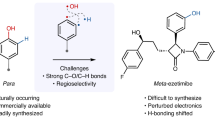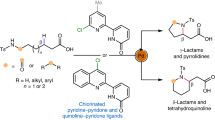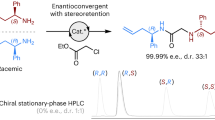Abstract
Direct and selective functionalization of hydrocarbon chains is a fundamental problem in synthetic chemistry. Conventional functionalization of C=C double bonds and C(sp3)–H bonds provides some solutions, but site diversity remains an issue. The merging of alkene isomerization with (oxidative) functionalization provides an ideal method for remote functionalization, which would provide more opportunities for site diversity. However, the reported functionalized sites are still limited and focus on a specific terminal position and internal site; new site-selective functionalization, including multi-functionalization, remains a largely unmet challenge. Here we describe a palladium-catalysed aerobic oxidative method for the multi-site programmable functionalization, involving the C=C double bond and multiple C(sp3)–H bonds, of terminal olefins via a strategy that controls the reaction sequence between alkene isomerization and oxidative functionalization. Specifically, 1-acetoxylation (anti-Markovnikov), 2-acetoxylation, 1,2-diacetoxylation and 1,2,3-triacetoxylation have been realized, accompanied by controllable remote alkenylation. This method enables available terminal olefins from petrochemical feedstocks to be readily converted into unsaturated alcohols and polyalcohols and particularly into different monosaccharides and C-glycosides.

This is a preview of subscription content, access via your institution
Access options
Access Nature and 54 other Nature Portfolio journals
Get Nature+, our best-value online-access subscription
$29.99 / 30 days
cancel any time
Subscribe to this journal
Receive 12 print issues and online access
$259.00 per year
only $21.58 per issue
Buy this article
- Purchase on Springer Link
- Instant access to full article PDF
Prices may be subject to local taxes which are calculated during checkout



Similar content being viewed by others
Data availability
The data supporting the findings of this study are available within the Article and its Supplementary Information.
References
McDonald, R. I., Liu, G. & Stahl, S. S. Palladium(II)-catalyzed alkene functionalization via nucleopalladation: stereochemical pathways and enantioselective catalytic applications. Chem. Rev. 111, 2981–3019 (2011).
Mann, S. E., Benhamou, L. & Sheppard, T. D. Palladium(II)-catalysed oxidation of alkenes. Synthesis 47, 3079–3117 (2015).
Hemric, B. M. Beyond osmium: progress in 1,2-amino oxygenation of alkenes, 1,3-dienes, alkynes, and allenes. Org. Biomol. Chem. 19, 46–81 (2021).
He, J., Wasa, M., Chan, K. S. L., Shao, Q. & Yu, J.-Q. Palladium-catalyzed transformations of alkyl C–H bonds. Chem. Rev. 117, 8754–8786 (2017).
Voica, A.-F., Mendoza, A., Gutekunst, W. R., Fraga, J. O. & Baran, P. S. Guided desaturation of unactivated aliphatics. Nat. Chem. 4, 629–635 (2012).
Chu, J. C. K. & Rovis, T. Amide-directed photoredox-catalysed C–C bond formation at unactivated sp3 C–H bonds. Nature 539, 272–275 (2016).
Choi, G. J., Zhu, Q., Miller, D. C., Gu, C. J. & Knowles, R. R. Catalytic alkylation of remote C–H bonds enabled by proton-coupled electron transfer. Nature 539, 268–271 (2016).
Chan, H. S. S., Yang, J.-M. & Yu, J.-Q. Catalyst-controlled site-selective methylene C–H lactonization of dicarboxylic acids. Science 376, 1481–1487 (2022).
Vasseur, A., Bruffaerts, J. & Marek, I. Remote functionalization through alkene isomerization. Nat. Chem. 8, 209–219 (2016).
Janssen-Müller, D., Sahoo, B., Sun, S.-Z. & Martin, R. Tackling remote sp3 C–H functionalization via Ni-catalyzed ‘chain-walking’ reactions. Isr. J. Chem. 60, 195–206 (2020).
Dhungana, R. K., Sapkota, R. R., Niroula, D. & Giri, R. Walking metals: catalytic difunctionalization of alkenes at nonclassical sites. Chem. Sci. 11, 9757–9774 (2020).
Li, Y., Wu, D., Cheng, H.-G. & Yin, G. Difunctionalization of alkenes involving metal migration. Angew. Chem. Int. Ed. 59, 7990–8003 (2020).
Fiorito, D., Scaringi, S. & Mazet, C. Transition metal-catalyzed alkene isomerization as an enabling technology in tandem, sequential and domino processes. Chem. Soc. Rev. 50, 1391–1406 (2021).
Bonfield, H. E., Valette, D., Lindsay, D. M. & Reid, M. Stereoselective remote functionalization via palladium-catalyzed redox-relay Heck methodologies. Chem. Eur. J. 27, 158–174 (2021).
Massad, I., Suresh, R., Segura, L. & Marek, I. Stereoselective synthesis through remote functionalization. Nat. Synth. 1, 37–48 (2022).
Seayad, A. et al. Internal olefins to linear amines. Science 297, 1676–1678 (2002).
Obligacion, J. V. & Chirik, P. J. Bis(imino)pyridine cobalt-catalyzed alkene isomerization-hydroboration: a strategy for remote hydrofunctionalization with terminal selectivity. J. Am. Chem. Soc. 135, 19107–19110 (2013).
Atienza, C. C. H. et al. Bis(imino)pyridine cobalt-catalyzed dehydrogenative silylation of alkenes: scope, mechanism, and origins of selective allylsilane formation. J. Am. Chem. Soc. 136, 12108–12118 (2014).
Buslov, I., Becouse, J., Mazza, S., Montandon-Clerc, M. & Hu, X. L. Chemoselective alkene hydrosilylation catalyzed by nickel pincer complexes. Angew. Chem. Int. Ed. 54, 14523–14526 (2015).
Jia, X. & Huang, Z. Conversion of alkanes to linear alkylsilanes using an iridium–iron-catalysed tandem dehydrogenation–isomerization–hydrosilylation. Nat. Chem. 8, 157–161 (2016).
Dupuy, S., Zhang, K. F., Goutierre, A. S. & Baudoin, O. Terminal-selective functionalization of alkyl chains by regioconvergent cross-coupling. Angew. Chem. Int. Ed. 55, 14793–14797 (2016).
Juliá-Hernández, F., Moragas, T., Cornella, J. & Martin, R. Remote carboxylation of halogenated aliphatic hydrocarbons with carbon dioxide. Nature 545, 84–88 (2017).
Yang, J. et al. Direct synthesis of adipic acid esters via palladium-catalyzed carbonylation of 1,3-dienes. Science 366, 1514–1517 (2019).
Li, X., Jin, J., Chen, P. & Liu, G. Catalytic remote hydrohalogenation of internal alkenes. Nat. Chem. 14, 425–432 (2022).
Masarwa, A. et al. Merging allylic carbon–hydrogen and selective carbon–carbon bond activation. Nature 505, 199–203 (2014).
Hamasaki, T., Aoyama, Y., Kawasaki, J., Kakiuchi, F. & Kochi, T. Chain walking as a strategy for carbon–carbon bond formation at unreactive sites in organic synthesis: catalytic cycloisomerization of various 1,n-dienes. J. Am. Chem. Soc. 137, 16163–16171 (2015).
He, Y., Cai, Y. & Zhu, S. Mild and regioselective benzylic C–H functionalization: Ni-catalyzed reductive arylation of remote and proximal olefins. J. Am. Chem. Soc. 139, 1061–1064 (2017).
Kundu, G., Opincal, F., Sperger, T. & Schoenebeck, F. Air-stable PdI dimer enabled remote functionalization: access to fluorinated 1,1-diaryl alkanes with unprecedented speed. Angew. Chem. Int. Ed. 61, e202113667 (2022).
Xiao, J., He, Y., Ye, F. & Zhu, S. Remote sp3 C–H amination of alkenes with nitroarenes. Chem 4, 1645–1657 (2018).
Yu, X. et al. Site-selective alkene borylation enabled by synergistic hydrometallation and borometallation. Nat. Catal. 3, 585–592 (2020).
Lee, C., Seo, H., Jeon, J. & Hong, S. γ-Selective C(sp3)–H amination via controlled migratory hydroamination. Nat. Commun. 12, 5657–5665 (2021).
Werner, E. W., Mei, T.-S., Burckle, A. J. & Sigman, M. S. Enantioselective Heck arylations of acyclic alkenyl alcohols using a redox-relay strategy. Science 338, 1455–1458 (2012).
Mei, T.-S., Patel, H. H. & Sigman, M. S. Enantioselective construction of remote quaternary stereocentres. Nature 508, 340–344 (2014).
Singh, S., Bruffaerts, J., Vasseur, A. & Marek, I. A unique Pd-catalysed Heck arylation as a remote trigger for cyclopropane selective ring-opening. Nat. Commun. 8, 14200–14209 (2017).
Kohler, D. G., Gockel, S. N., Kennemur, J. L., Waller, P. J. & Hull, K. L. Palladium-catalysed anti-Markovnikov selective oxidative amination. Nat. Chem. 10, 333–340 (2018).
Kou, X., Shao, Q., Ye, C., Yang, G. & Zhang, W. Asymmetric aza-Wacker-type cyclization of N-Ts hydrazine-tethered tetrasubstituted olefins: synthesis of pyrazolines bearing one quaternary or two vicinal stereocenters. J. Am. Chem. Soc. 140, 7587–7597 (2018).
Liu, J., Yuan, Q., Toste, F. D. & Sigman, M. S. Enantioselective construction of remote tertiary carbon–fluorine bonds. Nat. Chem. 11, 710–715 (2019).
Han, C. et al. Palladium-catalyzed remote 1,n-arylamination of unactivated terminal alkenes. ACS Catal. 9, 4196–4202 (2019).
Wang, W. et al. Migratory arylboration of unactivated alkenes enabled by nickel catalysis. Angew. Chem. Int. Ed. 58, 4612–4616 (2019).
Larionov, E., Li, H. & Mazet, C. Well-defined transition metal hydrides in catalytic isomerizations. Chem. Commun. 50, 9816–9826 (2014).
Frech, C. M., Leitus, G. & Milstein, D. Processes involved in the reduction of a cyclometalated palladium(II) complex. Organometallics 27, 894–899 (2008).
Henriksen, S. T., Tanner, D., Cacchi, S. & Norrby, P.-O. DFT-based explanation of the effect of simple anionic ligands on the regioselectivity of the Heck arylation of acrolein acetals. Organometallics 28, 6201–6205 (2009).
Ambrogio, I. et al. Unusual selectivity-determining factors in the phosphine-free Heck arylation of allyl ethers. Organometallics 27, 3187–3195 (2008).
Sato, S., Sato, F., Gotoh, H. & Yamada, Y. Selective dehydration of alkanediols into unsaturated alcohols over rare earth oxide catalysts. ACS Catal. 3, 721–734 (2013).
Osborn, H. M. I. (ed.) Best Synthetic Methods: Carbohydrates (Elsevier Science Ltd, 2003).
Frihed, T. G., Bols, M. & Pedersen, C. M. Synthesis of l-hexoses. Chem. Rev. 115, 3615–3676 (2015).
Wong, C.-H. (ed.) Carbohydrate-Based Drug Discovery (Wiley-VCH Verlag GmbH & Co. KGaA, 2003).
Stoltz, B. M. Palladium catalyzed aerobic dehydrogenation: from alcohols to indoles and asymmetric catalysis. Chem. Lett. 33, 362–367 (2004).
Muzart, J. Progress in the synthesis of aldehydes from Pd-catalyzed Wacker-type reactions of terminal olefins. Tetrahedron 87, 132024 (2021).
Keith, J. A. & Henry, P. M. The mechanism of the Wacker reaction: a tale of two hydroxypalladations. Angew. Chem. Int. Ed. 48, 9038–9049 (2009).
Acknowledgements
We are grateful for financial support provided by the National Natural Science Foundation of China (Nos 21620102003, 21831005 and 21991112 to W.Z.), the National Key R&D Program of China (No. 2018YFE0126800 to W.Z.) and the Shanghai Municipal Education Commission (No. 201701070002E00030 to W.Z.). We thank the Instrumental Analysis Center of SJTU for characterization experiments. We are grateful to Q. Ge and C. Xu for their contribution concerning the purification of compounds.
Author information
Authors and Affiliations
Contributions
W.Z. and Z.W. conceived the work and designed the experiments. Z.W. performed the experiments and analysed the data. J.M., Y.L., H.L. and X.Z. performed the experiments. W.Z. and Z.W. wrote the paper. W.Z. guided the project. All the authors checked the paper.
Corresponding author
Ethics declarations
Competing interests
The authors declare no competing interests.
Peer review
Peer review information
Nature Chemistry thanks the anonymous reviewers for their contribution to the peer review of this work.
Additional information
Publisher’s note Springer Nature remains neutral with regard to jurisdictional claims in published maps and institutional affiliations.
Supplementary information
Supplementary Information
Supplementary Figs. 1–28, Tables 1–6, synthesis and characterization data, supplementary discussion, computational and procedural details, NMR spectra and references.
Supplementary Data 1
Cartesian coordinates (x,y,z) and coupling constants.
Rights and permissions
Springer Nature or its licensor (e.g. a society or other partner) holds exclusive rights to this article under a publishing agreement with the author(s) or other rightsholder(s); author self-archiving of the accepted manuscript version of this article is solely governed by the terms of such publishing agreement and applicable law.
About this article
Cite this article
Wu, Z., Meng, J., Liu, H. et al. Multi-site programmable functionalization of alkenes via controllable alkene isomerization. Nat. Chem. 15, 988–997 (2023). https://doi.org/10.1038/s41557-023-01209-x
Received:
Accepted:
Published:
Issue Date:
DOI: https://doi.org/10.1038/s41557-023-01209-x



